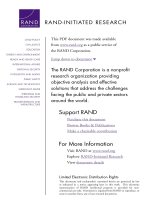AN0872 upgrading from the MCP2510 to the MCP2515
Bạn đang xem bản rút gọn của tài liệu. Xem và tải ngay bản đầy đủ của tài liệu tại đây (207.81 KB, 6 trang )
M
AN872
Upgrading from the MCP2510 to the MCP2515
Author:
Pat Richards
Microchip Technology Inc.
MCP2515 ENHANCEMENTS AND
DIFFERENCES
INTRODUCTION
Enhancements
The MCP2510 stand-alone CAN controller was
originally developed to give CAN system and module
designers more flexibility in their design by allowing
them to choose the best processor for their application.
By using the MCP2510, designers were not restricted
to using processors with integrated CAN controllers.
The enhancements in the MCP2515 are designed as a
super-set to the basic functionality of the MCP2510.
These enhancements include:
Today, the CAN market continues to grow and
proliferate into other markets and different applications
and, both increasingly complex nodes and simpler
nodes are being developed to further distribute control
among the CAN network. The complex nodes may
require using a 32-bit MCU, ASIC, CPLD, DSP or some
other device that does not have an on-board CAN
controller. The simple nodes may only require small
program space and not need all of the extra peripherals
found on many of the MCUs with integrated CAN.
The MCP2515 addresses these new market needs,
and is designed to be pin and functionally compatible to
the MCP2510. All known MCP2510 errata have been
addressed in the MCP2515. Additionally, there are
several enhancements with the MCP2515, designed
for increased performance.
While the MCP2515 was designed to be functionally
compatible to the MCP2510, there are some
differences between the two devices due to both the
MCP2510 errata being fixed and the enhanced
features of the MCP2515. These differences should be
invisible in most applications that choose to upgrade to
the MCP2515. This application note discusses the
differences between the MCP2510 and MCP2515 (and
the possible impact of these differences) in an effort to
assist with the upgrade process.
• 40 MHz operation
• 10 MHz Serial Peripheral Interface™ (SPI™)
• Data byte filtering on the first 16 bits in the data
field (standard 11-bit frames only)
• One-shot mode to automatically abort messages
that lose arbitration or are interrupted by an error
frame
• Start-of-Frame (SOF) output pin used to detect
valid start-of-frames
• Three new SPI instructions:
- Read RX Buffer Command
Eliminates the eight bit address required by a
normal read command.
Eight bit instruction that sets the address
pointer to one of four addresses depending
on two bits. Points to the “ID” or “data” of the
two receive buffers.
- RX Status Command
Used to quickly read important information
about a received message.
Eight bit instruction followed by the status of
received message: Standard/Extended,
Frame Type (data frame/remote) and filter
match.
- Load TX Buffer Command
Eliminates the eight bit address required by a
normal write command.
Eight bit instruction that sets the address
pointer to one of six addresses to quickly
write to a transmit buffer. Points to the “ID” or
“data” address of any of the three transmit
buffers.
Differences
A summary of the differences (including the
enhancements and other changes) is shown in Table 1.
The sections following the table decribe each
difference in greater detail.
2003 Microchip Technology Inc.
DS00872A-page 1
AN872
TABLE 1:
MCP2510 TO MCP2515 UPGRADE COMPARISON
Description
FOSC (max)
SPI clock (max)
Operating voltage
Data byte filtering
One-shot mode
SOF signal
Three new SPI
Instructions
Clocks on CLKOUT
before sleep
Setting ABAT bit
MCP2515
40 MHz
10 MHz
2.7V to 5.5V
The mask registers
POR state is zero
(i.e., masks are off).
Ensures that the
transmit message is
attempted only one
time.
Generates a pulse
output at the
beginning of a
message.
Speeds up data
throughput.
17
MCP2510
25 MHz
5 MHz
3.0V to 5.5V
None. The mask
registers POR state
is unknown.
Not implemented
Minimal
Not implemented
Minimal
Not implemented
None
16
None
Sets abort flag
(ABTF) only if
TXREQ is set
Aborting pending
Can only abort
messages
pending messages
that have not
attempted to
transmit.
Flags will clear if
Flags do not clear
Error warning flags
when transitioning to device transitions to
(EWARN and
receive error passive. receive error
RXWARN)
passive.
REQOP =
Sleep mode
REQOP changes to
OPMODE = b’001’
b’011’ after entering
sleep. OPMOD
indicates Sleep mode.
REQOP bits while in REQOP bits are read- REQOP bits are
readable and
Sleep mode
only while in Sleep
writable.
mode.
Requesting Sleep
Will wait until bus idle. Enters immediately
mode
Standby current
8 µA max at 125°C
5 µA max all temps
SPI Bit Modify
Command
Error counters
Reading masks and
filters
DS00872A-page 2
Sets abort flag
(ABTF) regardless of
TXREQ.
Can abort any
pending message.
Using command on
other registers forces
mask = FFh.
Does not reset when
entering Listen-only
mode.
Can only read in
Configuration mode.
Reads 00h in other
modes.
Upgrade
Impact
Can only use for
specific registers.
Reset when
entering Listen-only
mode.
Can read in any
mode.
None
None
None
Minimal
Minimal
Comments
May affect operation if RXNnEID8
and RXMnEID0 are initialized to
non-zero values.
The OSM bit is in the CANCTRL
register (unused in the MCP2510,
bit default = 0).
The SOF signal control bit is in the
CNF3 register (unused in the
MCP2510, bit default = 0).
One extra clock pulse with the
MCP2515 before going to sleep.
MCP2515 clears TXREQ without
checking if set.
None
Minimal
The INT pin operation will remain
the same if flags are enabled.
Minimal
REQOP is only used to request
operation modes. OPMOD is used
to determine the mode.
None
Neither device can wakeup from
sleep by modifying the REQOP bits.
None
MCP2510 should not be requesting
Sleep mode until bus is idle.
MCP2515 standby currents are
similar to the MCP2510 at all other
temperatures.
Minimal
None
Minimal
Error counters deactivate on both
devices while in Listen-only mode.
Minmal
The masks and filters will typically
only be read while in Configuration
mode.
2003 Microchip Technology Inc.
AN872
FOSC
Start-of-Frame (SOF) Signal
The maximum frequency of operation for the MCP2510
is 25 MHz (16 MHz for low voltage), whereas the
maximum for the MCP2515 is 40 MHz (25 MHz for low
voltage).
The MCP2515 implements a feature that, if enabled,
will generate a pulse on the CLKOUT/SOF pin if the
RXCAN pin detects the beginning of a CAN message.
There is no impact when upgrading to the MCP2515.
SPI Clock
The maximum SPI frequencies for the MCP2510:
• 5 MHz for V DD > 4.5V
• 4 MHz for E-temp VDD > 4.5V
• 2.5 MHz for VDD = 3.0 to 4.5V
The maximum SPI clock frequency for the MCP2515 is
10 MHz across all voltages and temperatures.
There is no impact when upgrading to the MCP2515.
Operating Voltage
The SOF bit is located in CNF3.bit7. This location is
unused and reads zero on the MCP2510.
If the original application does not attempt to initialize
this location to a logic one (which it should not because
the bit is unimplemented in the MCP2510), then using
the MCP2515 will have no effect on the operation.
Three New SPI Instructions
See the "Enhancements" section and the MCP2515
data sheet for details.
Number of Clocks on CLKOUT Pin Before
Entering Sleep Mode
There is no impact when upgrading to the MCP2515.
After requesting Sleep mode, the MCP2510 generates
16 additional clocks on CLKOUT (if enabled) before
entering Sleep mode. The MCP2515 generates 17
additional clocks.
Data Byte Filtering
Setting ABAT Bit to Abort Messages
When receiving standard data frames (11-bit identifier),
the MCP2515 automatically applies 16 bits of the
masks and filters normally associated with extended
identifiers to the first 16-bits of the data field (data bytes
0 and 1). The MCP2510 does not have this feature.
The MCP2510 will only set the abort flag
(TXBnCTRL.ABTF) when requesting an abort via
CANCTRL.ABAT if the associated message was
pending (TXREQ = 1) and then successfully aborted.
The MCP2510 operates from 3.0V to 5.5V, while the
MCP2515 operates from 2.7V to 5.5V.
The difference between the MCP2510 and MCP2515 is
the POR default state of the extended mask registers
(RXMnEID8 and RXMnEID0). The MCP2510 POR
defaults are undefined and can power-up in any state.
The MCP2515 POR defaults equals zero for these
registers to effectively turn the masks off (i.e., do not
apply filters to the data bytes).
If the original application with the MCP2510 does not
use extended frames and does not initialize the
extended mask registers (or initializes them to zero),
the MCP2515 can be placed in the socket with no MCU
firmware modifications.
One-shot Mode
The MCP2515 implements a feature to ensure that a
transmit message is attempted only one time. With
One-shot mode enabled, a message will attempt
transmission only one time, regardless of arbitration
loss or error frame.
This enable bit is located in CANCTRL.bit3. This
location is unused and reads zero in the MCP2510.
If the original application does not attempt to initialize
this location to a logic one (which it should not because
the bit is unimplemented in the MCP2510), then using
the MCP2515 will have no effect on the operation.
2003 Microchip Technology Inc.
The MCP2515 sets the abort flag (TXBnCTRL.ABTF)
regardless of the associated TXREQ value. However,
the MCP2515 will abort the message if it is pending.
Using the MCP2515 in an application designed for the
MCP2510 will have very little impact because the
MCP2515 is better at aborting messages (see
“Aborting Pending Messages”).
Aborting Pending Messages
The MCP2510 can only abort messages that are
pending and have not attempted to transmit. This
includes messages that go back to the pending state
due to loss of arbitration, error frames, etc. This is
because the TXBnCTRL.TXREQ bit gets locked out
and cannot be cleared if the associated buffer attempts
to transmit. The only exception is if another transmit
buffer becomes pending and has a higher buffer
priority.
The MCP2515 can abort any pending message.
Setting CANCTRL.ABAT will clear the associated
TXREQ bit. If the transmitting buffer is interrupted, it
checks the TXREQ bit before attempting to transmit
again, and if cleared, will not attempt to transmit.
The enhanced aborting capabilities of the MCP2515
should have minimal affect when replacing the
MCP2510.
DS00872A-page 3
AN872
Error Warning Flags (EWARN and
RXWARN)
The EWARN and RXWARN flag bits, located in EFLG,
will clear if the MCP2510 transitions from error-warning
to error-passive.
For the MCP2515, the EWARN and RXWARN bits stay
set if the device transitions to error-passive.
The impact when upgrading to the MCP2515 should be
minimal because an interrupt is generated (if enabled)
whenever either condition is true. If polling for the error
condition, it is possible (though not probable) that the
firmware could mistake an error-passive state as an
error-warning state.
Sleep Mode
To enter Sleep mode with either device, the
CANCTRL.REQOP bits equal b’001’. Once in Sleep
mode, the REQOP bits remain unchanged in the
MCP2510. However, the MCP2515 REQOP bits will
change to b’011’ to request Listen-only mode as soon
as the device wakes up from Sleep mode. Note that the
CANSTAT.OPMOD bits still reflect the current mode,
which is Sleep in this case.
The MCP2515 should have minimal affect on the
application when replacing the MCP2510 because the
application should read CANSTAT.OPMOD when
checking the operation mode. The REQOP bits are
only used for requesting modes of operation, not
verifying modes.
Modifying REQOP Bits While In Sleep
Mode
The CANCTRL.REQOP bits are writable on the
MCP2510 while in Sleep mode. The REQOP bits are
read-only on the MCP2515 while in Sleep mode.
The impact of upgrading to the MCP2515 should be
minimal because the modes cannot be changed on
either device while in Sleep mode.
The impact of an upgrade should be minimal because
the typical currents between the two devices are
extremely similar.
SPI Bit Modify Command
On the MCP2510, the Bit Modify command can only be
used on specific registers, as identified in the device’s
data sheet. While this is essentially true for the
MCP2515 as well, if a Bit Modify command is used on
a register whose bits cannot be modified, the mask
byte is ignored and effectively becomes FFh. The
command is basically a byte write command with eight
extra clocks (mask byte).
There should be no impact when upgrading to the
MCP2515 because the MCP2510 application would
not attempt to Bit Modify a register whose bits cannot
be modified.
Error Counters While In Listen-only mode
The MCP2510 error counters are reset and deactivated
while in Listen Only mode. The MCP2515 error
counters are not reset, but are still deactivated, while in
Listen-only mode.
The impact when upgrading to the MCP2515 should be
minimal.
Reading The Mask And Filters While Not
In Configruation Mode
The MCP2510 can read the masks and filters in all
modes, while the MCP2515 can only read the masks
and filters while in Configuration mode. The registers
will read 00h while not in Configuration mode. This
serves as a positive lockout for the other modes.
The impact when upgrading should be minimal
because the masks and filters on either device can be
modified only when in Configuration mode. The masks
and filters most likely will not need to be read after
leaving Configuration mode.
Requesting Sleep Mode
SUMMARY
When requesting Sleep mode, the MCP2510 will
immediately enter Sleep mode, regardless of bus
activity. The MCP2515 will wait until a bus idle condition
before entering Sleep mode.
While the MCP2515 was designed to be pin and
functionally compatible with the MCP2510, there are
some differences between the devices due to
enhancements, errata fixes, design differences,
process differences, etc. that the MCP2515
incorporates.
There should be no negative impact when upgrading to
the MCP2515.
Standby Current
The maximum standby (Sleep mode) current on the
MCP2510 is 5 µA across all temperatures. The
maximum standby current on the MCP2515 is 5 µA for
temperatures up to 85°C and 8 µA for temperatures
from 85°C to 125°C.
DS00872A-page 4
This application note helps the design engineer
determine the impact of upgrading their system or
module from an MCP2510 to a MCP2515. In most
cases, the impact should be nonexistent (or invisible)
because the functional differences are a superset of
the MCP2510 functinality.
2003 Microchip Technology Inc.
Note the following details of the code protection feature on Microchip devices:
•
Microchip products meet the specification contained in their particular Microchip Data Sheet.
•
Microchip believes that its family of products is one of the most secure families of its kind on the market today, when used in the
intended manner and under normal conditions.
•
There are dishonest and possibly illegal methods used to breach the code protection feature. All of these methods, to our
knowledge, require using the Microchip products in a manner outside the operating specifications contained in Microchip's Data
Sheets. Most likely, the person doing so is engaged in theft of intellectual property.
•
Microchip is willing to work with the customer who is concerned about the integrity of their code.
•
Neither Microchip nor any other semiconductor manufacturer can guarantee the security of their code. Code protection does not
mean that we are guaranteeing the product as “unbreakable.”
Code protection is constantly evolving. We at Microchip are committed to continuously improving the code protection features of our
products. Attempts to break microchip’s code protection feature may be a violation of the Digital Millennium Copyright Act. If such acts
allow unauthorized access to your software or other copyrighted work, you may have a right to sue for relief under that Act.
Information contained in this publication regarding device
applications and the like is intended through suggestion only
and may be superseded by updates. It is your responsibility to
ensure that your application meets with your specifications.
No representation or warranty is given and no liability is
assumed by Microchip Technology Incorporated with respect
to the accuracy or use of such information, or infringement of
patents or other intellectual property rights arising from such
use or otherwise. Use of Microchip’s products as critical
components in life support systems is not authorized except
with express written approval by Microchip. No licenses are
conveyed, implicitly or otherwise, under any intellectual
property rights.
Trademarks
The Microchip name and logo, the Microchip logo, dsPIC,
KEELOQ, MPLAB, PIC, PICmicro, PICSTART, PRO MATE and
PowerSmart are registered trademarks of Microchip
Technology Incorporated in the U.S.A. and other countries.
FilterLab, microID, MXDEV, MXLAB, PICMASTER, SEEVAL
and The Embedded Control Solutions Company are
registered trademarks of Microchip Technology Incorporated
in the U.S.A.
Accuron, Application Maestro, dsPICDEM, dsPICDEM.net,
ECAN, ECONOMONITOR, FanSense, FlexROM, fuzzyLAB,
In-Circuit Serial Programming, ICSP, ICEPIC, microPort,
Migratable Memory, MPASM, MPLIB, MPLINK, MPSIM,
PICC, PICkit, PICDEM, PICDEM.net, PowerCal, PowerInfo,
PowerMate, PowerTool, rfLAB, rfPIC, Select Mode,
SmartSensor, SmartShunt, SmartTel and Total Endurance are
trademarks of Microchip Technology Incorporated in the
U.S.A. and other countries.
Serialized Quick Turn Programming (SQTP) is a service mark
of Microchip Technology Incorporated in the U.S.A.
All other trademarks mentioned herein are property of their
respective companies.
© 2003, Microchip Technology Incorporated, Printed in the
U.S.A., All Rights Reserved.
Printed on recycled paper.
Microchip received QS-9000 quality system
certification for its worldwide headquarters,
design and wafer fabrication facilities in
Chandler and Tempe, Arizona in July 1999
and Mountain View, California in March 2002.
The Company’s quality system processes and
procedures are QS-9000 compliant for its
PICmicro® 8-bit MCUs, KEELOQ® code hopping
devices, Serial EEPROMs, microperipherals,
non-volatile memory and analog products. In
addition, Microchip’s quality system for the
design and manufacture of development
systems is ISO 9001 certified.
DS00872A-page 5
2003 Microchip Technology Inc.
M
WORLDWIDE SALES AND SERVICE
AMERICAS
ASIA/PACIFIC
Corporate Office
Australia
2355 West Chandler Blvd.
Chandler, AZ 85224-6199
Tel: 480-792-7200
Fax: 480-792-7277
Technical Support: 480-792-7627
Web Address:
Suite 22, 41 Rawson Street
Epping 2121, NSW
Australia
Tel: 61-2-9868-6733
Fax: 61-2-9868-6755
Atlanta
Unit 915
Bei Hai Wan Tai Bldg.
No. 6 Chaoyangmen Beidajie
Beijing, 100027, No. China
Tel: 86-10-85282100
Fax: 86-10-85282104
3780 Mansell Road, Suite 130
Alpharetta, GA 30022
Tel: 770-640-0034
Fax: 770-640-0307
Boston
2 Lan Drive, Suite 120
Westford, MA 01886
Tel: 978-692-3848
Fax: 978-692-3821
Chicago
333 Pierce Road, Suite 180
Itasca, IL 60143
Tel: 630-285-0071
Fax: 630-285-0075
Dallas
4570 Westgrove Drive, Suite 160
Addison, TX 75001
Tel: 972-818-7423
Fax: 972-818-2924
Detroit
Tri-Atria Office Building
32255 Northwestern Highway, Suite 190
Farmington Hills, MI 48334
Tel: 248-538-2250
Fax: 248-538-2260
Kokomo
2767 S. Albright Road
Kokomo, IN 46902
Tel: 765-864-8360
Fax: 765-864-8387
Los Angeles
China - Beijing
China - Chengdu
Rm. 2401-2402, 24th Floor,
Ming Xing Financial Tower
No. 88 TIDU Street
Chengdu 610016, China
Tel: 86-28-86766200
Fax: 86-28-86766599
China - Fuzhou
Unit 28F, World Trade Plaza
No. 71 Wusi Road
Fuzhou 350001, China
Tel: 86-591-7503506
Fax: 86-591-7503521
China - Hong Kong SAR
Unit 901-6, Tower 2, Metroplaza
223 Hing Fong Road
Kwai Fong, N.T., Hong Kong
Tel: 852-2401-1200
Fax: 852-2401-3431
China - Shanghai
Room 701, Bldg. B
Far East International Plaza
No. 317 Xian Xia Road
Shanghai, 200051
Tel: 86-21-6275-5700
Fax: 86-21-6275-5060
China - Shenzhen
18201 Von Karman, Suite 1090
Irvine, CA 92612
Tel: 949-263-1888
Fax: 949-263-1338
Rm. 1812, 18/F, Building A, United Plaza
No. 5022 Binhe Road, Futian District
Shenzhen 518033, China
Tel: 86-755-82901380
Fax: 86-755-8295-1393
Phoenix
China - Shunde
2355 West Chandler Blvd.
Chandler, AZ 85224-6199
Tel: 480-792-7966
Fax: 480-792-4338
Room 401, Hongjian Building
No. 2 Fengxiangnan Road, Ronggui Town
Shunde City, Guangdong 528303, China
Tel: 86-765-8395507 Fax: 86-765-8395571
San Jose
China - Qingdao
2107 North First Street, Suite 590
San Jose, CA 95131
Tel: 408-436-7950
Fax: 408-436-7955
Rm. B505A, Fullhope Plaza,
No. 12 Hong Kong Central Rd.
Qingdao 266071, China
Tel: 86-532-5027355 Fax: 86-532-5027205
Toronto
India
6285 Northam Drive, Suite 108
Mississauga, Ontario L4V 1X5, Canada
Tel: 905-673-0699
Fax: 905-673-6509
Divyasree Chambers
1 Floor, Wing A (A3/A4)
No. 11, O’Shaugnessey Road
Bangalore, 560 025, India
Tel: 91-80-2290061 Fax: 91-80-2290062
Japan
Benex S-1 6F
3-18-20, Shinyokohama
Kohoku-Ku, Yokohama-shi
Kanagawa, 222-0033, Japan
Tel: 81-45-471- 6166 Fax: 81-45-471-6122
DS00872A-page 6
Korea
168-1, Youngbo Bldg. 3 Floor
Samsung-Dong, Kangnam-Ku
Seoul, Korea 135-882
Tel: 82-2-554-7200 Fax: 82-2-558-5932 or
82-2-558-5934
Singapore
200 Middle Road
#07-02 Prime Centre
Singapore, 188980
Tel: 65-6334-8870 Fax: 65-6334-8850
Taiwan
Kaohsiung Branch
30F - 1 No. 8
Min Chuan 2nd Road
Kaohsiung 806, Taiwan
Tel: 886-7-536-4818
Fax: 886-7-536-4803
Taiwan
Taiwan Branch
11F-3, No. 207
Tung Hua North Road
Taipei, 105, Taiwan
Tel: 886-2-2717-7175 Fax: 886-2-2545-0139
EUROPE
Austria
Durisolstrasse 2
A-4600 Wels
Austria
Tel: 43-7242-2244-399
Fax: 43-7242-2244-393
Denmark
Regus Business Centre
Lautrup hoj 1-3
Ballerup DK-2750 Denmark
Tel: 45-4420-9895 Fax: 45-4420-9910
France
Parc d’Activite du Moulin de Massy
43 Rue du Saule Trapu
Batiment A - ler Etage
91300 Massy, France
Tel: 33-1-69-53-63-20
Fax: 33-1-69-30-90-79
Germany
Steinheilstrasse 10
D-85737 Ismaning, Germany
Tel: 49-89-627-144-0
Fax: 49-89-627-144-44
Italy
Via Quasimodo, 12
20025 Legnano (MI)
Milan, Italy
Tel: 39-0331-742611
Fax: 39-0331-466781
Netherlands
P. A. De Biesbosch 14
NL-5152 SC Drunen, Netherlands
Tel: 31-416-690399
Fax: 31-416-690340
United Kingdom
505 Eskdale Road
Winnersh Triangle
Wokingham
Berkshire, England RG41 5TU
Tel: 44-118-921-5869
Fax: 44-118-921-5820
07/28/03
2003 Microchip Technology Inc.









